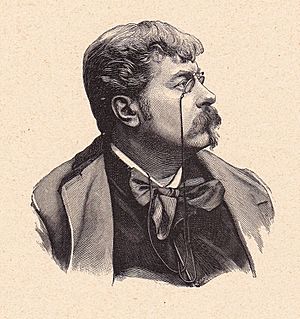Camille Lemonnier facts for kids
Quick facts for kids
Camille Lemonnier
|
|
|---|---|

Camille Lemonnier
|
|
| Born |
Antoine Louis Camille Lemonnier
24 March 1844 Ixelles, Belgium
|
| Died | 13 June 1913 (aged 69) Ixelles, Belgium
|
| Nationality | Belgian |
| Occupation | journalist, poet, writer |
Camille Lemonnier (born March 24, 1844 – died June 13, 1913) was a Belgian writer, poet, and journalist. He was part of a group called La Jeune Belgique, which focused on Symbolism. However, he became most famous for his realist stories, which showed life as it really was. His first book, Salon de Bruxelles (1863), was about art. His most famous novel is Un Mâle (1881).
Contents
Camille Lemonnier's Life Story
Lemonnier was born in Ixelles, a town in Brussels, Belgium. He studied law for a while. After that, he worked in a government office, but he left that job after three years.
Camille Lemonnier had Flemish family on both sides. This background gave him a strong connection to nature and a lively way of describing things. In 1863 and 1866, he published Salon de Bruxelles, which contained his thoughts on art. He was good friends with many artists early in his life. In 1868, he helped start the Société Libre des Beaux-Arts. This was a new group that wanted to try different styles in art.
Lemonnier moved to a house in the hills near Namur. There, he spent time enjoying sports and nature. This close connection to the outdoors greatly influenced his writing. Books like Nos Flamands (1869) and Croquis d'automne (1870) came from this period. In 1870, he wrote Paris-Berlin, a short book that spoke out against war and supported France. It became very popular.
His Novels and Stories
Lemonnier's talent for writing about everyday life in a funny and fresh way was first seen in Un Coin de village (1879). This book showed the lives of people in a small town.
His novel Un Mâle (1881) brought him a different kind of fame. This story is about a poacher (someone who hunts illegally) and a farmer's daughter. The wild forest is an important part of the story. The main character, Cachaprès, seems to be a part of the wild nature around him.
In 1883, Un Mâle was not chosen for a big literature prize. This made Lemonnier very popular, and many people supported him. They even held a special dinner for him.
Another important book was Le Mort (1882). It tells the story of two farmers who feel terrible guilt after committing a murder. Lemonnier later rewrote this story as a play in 1899. In 1889, he published Ceux de la glèbe, which he dedicated to the "children of the soil."
For a while, Lemonnier wrote about different topics. He created psychological novels, which explore people's minds and feelings. He also wrote more art criticism. These works were important, but they were more similar to French books of that time.
Some of his later famous novels include L'Arche, journal d'une maman (1894) and Le Vent dans les moulins (1901). The last one went back to telling stories about Flemish life.
Later Life and Influence
Camille Lemonnier spent a lot of time in Paris, France. He was one of the first writers to contribute to a famous magazine called Mercure de France.
When Lemonnier started writing, Belgian literature often lacked a clear style. He worked hard to create his own unique way of writing. He explained some of his writing process in a special introduction he wrote for Gustave Abel's book Labeur de la prose (1902). His writing style was grand and powerful. He sometimes used new words and interesting comparisons, which made his prose stand out.
Today, a street in western Ixelles is named in his honor: Rue Camille Lemonnier/Camille Lemonnierstraat.
Camille Lemonnier's Works
- Salon de Bruxelles (1863)
- Nos Flamands (1869)
- Croquis d'automne (1870)
- Paris-Berlin (1870)
- G. Courbet, et ses œuvres (1878)
- Un Coin de village (1879)
- Un Mâle (1881)
- Le Mort (1882)
- L'Hystérique (1885)
- Happe-chair (1886)
- L'Histoire des Beaux-Arts en Belgique 1830–1887 (1887)
- En Allemagne (1888)
- La Belgique (1888)
- Ceux de la glèbe (1889)
- Le Possédé (1890)
- La fin des bourgeois (1892)
- L'Arche, journal d'une maman (1894)
- La Faute de Mme Charvet (1895)
- L'Ile vierge (1897)
- L'Homme en amour (1897)
- Adam et Eve (1899)
- Au Cœur frais de la forêt (1900)
- C'était l'été (1900)
- Le Vent dans les moulins (1901)
- Le Petit Homme de Dieu (1902)
- Comme va le ruisseau (1903)
- Alfred Stevens et son œuvre (1906)
See also
 In Spanish: Camille Lemonnier para niños
In Spanish: Camille Lemonnier para niños

